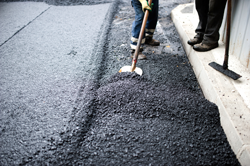 If you’re surprised by the idea of sustainable asphalt, you may not realize that asphalt is the number one recycled material in America. From the production of the paving material, to the placement of the pavement on the road, to rehabilitation through recycling, asphalt pavements can reduce the overall impact on the environment.
If you’re surprised by the idea of sustainable asphalt, you may not realize that asphalt is the number one recycled material in America. From the production of the paving material, to the placement of the pavement on the road, to rehabilitation through recycling, asphalt pavements can reduce the overall impact on the environment.
Low consumption of energy production through the use of Warm-mix asphalt, and low emission of greenhouse gases, and conservation of natural resources help to make asphalt an environmentally friendly pavement.
Asphalt Recycling and Energy Reduction
Reclaimed asphalt pavement (RAP) can be recycled into asphalt pavements that save the American taxpayer $1.8 billion per year. It also saves hundreds of acres of landfill space each year. There are even advantages for you personally to use recycled asphalt, as recycled asphalt can increase the durability of your pavement projects, allowing them to last longer.
Asphalt for Cleaner Air
While production has increased tremendously (250 percent!), since 1970 emissions from asphalt plants have managed to decrease by 97 percent. This means emissions from asphalt plants are now so low, even the EPA considers them as only minor sources of industrial pollution. Asphalt also produces fewer greenhouse gasses when you’re stuck in traffic - something you’ll thank the next time you’re in a traffic jam.
Lower Nighttime Temperatures
Porous asphalt pavements have been shown to lower nighttime surface temperatures when compared to impervious pavements like airport runways. If you’ve ever noticed that your nearest big city is warmer than other areas, you’ll understand just how important this is.
Porous Pavement is Better for the Environment
Porous asphalt pavements influence development plans in-line with natural processes and sustainability. They conserve water, reduce runoff, promote infiltration, which cleanses storm water, replenish aquifers, and protect streams.
NAPA is quoted to say, “A typical porous pavement has an open-graded surface over an underlying stone recharge bed. The water drains through the porous asphalt and into the stone bed, then, slowly infiltrates into the soil. If contaminants were on the surface at the time of the storm, they are swept along with the rainfall through the stone bed. From there they infiltrate into the sub-base so that they are subjected to the natural processes that cleanse water.”
Who knew the type of pavement you use could actually clean up the environment?
Ready to move forward? If you’ve decided to use sustainable asphalt in your next project, it’s important to know your asphalt partner is using the most up-to-date equipment to meet sustainability requirements. Unfortunately, improper technique can actually harm the environment, so for truly sustainable asphalt, make sure you are using a reliable and trustworthy asphalt partner.
Source: Black And Green Report: Sustainable Asphalt, Now and Tomorrow.
Of the 2.6 million miles of paved roads in the United States, over 94 percent are surfaced with asphalt. Approximately 85 percent of the nation’s airfield pavements and 85 percent of the parking lots are also surfaced with asphalt. There are about 4,000 asphalt mixing plants located in the United States and the industry employs, directly or indirectly, 300,000 U.S. workers. Because of the vast extent of use of this material, even small changes in asphalt pavement technology can make a big difference in terms of greenhouse gas emissions …


